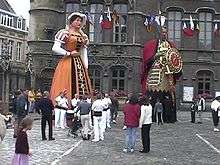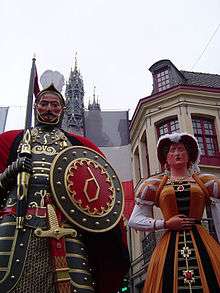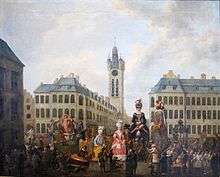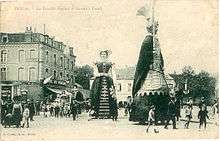Gayant
Gayant the giant is the symbol of Douai. Each year for three days at the beginning of July, the Gayant festival takes place. The Gayant family, composed of the giant's wife Marie Cagenon and their three children, Jacquot, Fillon and Binbin, are carried through the city. On Sunday the largest procession starts from the town hall. Gayant is registered with the Masterpieces of the Oral and Intangible Heritage of Humanity like member of Giants and processional dragons of Belgium and France.




Gayant family
Data on the family
| Data | Gayant | Marie Cagenon | Jacquot | Fillon | Binbin |
|---|---|---|---|---|---|
| First appearance | 1530 | 1531 | 1675 | 1687 | 1715 |
| Today shape | 1954 | 1954 | 1947 | 1947 | 1947 |
| Height (m) | 8.51 m | 6.26 m | 3.40 m | 3.15 m | 2.42 m |
| Weight (Kg) | 375 kg | 250 kg | 80 kg | 70 kg | 45 kg |
| Carrier(s) | 6 Carriers | 6 carriers | 1 carrier | 1 carrier | 1 carrier |
Today the giant family is the result of successive construction/rebuilding sessions ('NR'), restorations ('R') and "disappearances" ('D'). The dates [1] of the first representations were independent from/to each other, the main dates are:
- For Gayant: 1530 (NR), 1690 (R), 1692 (NR), 1700 [2] (R), 1703 (NR), 1712 (NR), 1716 (R), 1719 (R), 1723 (R), 1724 (R), 1734 (R), 1741 (R), 1779 [2], 1785 (NR), 1792 (D), 1801 (NR), 1809 (R), 1823 (NR)
- For Marie-Cagenon: 1531 (NR), 1712 (R),
1714 (NR), 1719 (R), 1792 (D), 1801 (NR), 1823 (NR)
- For Jacquot: 1675 (NR), 1719 (R), 1724 (R), 1741 (R), 1780 (R), 1792 (D), 1801 (NR), 1809 (R), 1827 (NR)
- For Fillon: 1678 (NR), 1724 (R), 1741 (R), 1782 (R), 1792 (D), 1801 (NR), 1809 (R), 1827 (NR)
- For Binbin: 1715 (NR), 1719 (R), 1724 (R), 1741 (R), 1780 (R), 1792 (D), 1801 (NR), 1809 (R), 1827 (NR)
Since 1827, the operations of restorations or rebuildings of the whole of the family have been coordinated. The main dates are 1859, 1867, 1874, 1881, 1885, 1892, 1912, 1922, 1947 and 1954. Each year, the mannequins, which are constructed of wicker are cleaned and restored to avoid heavy reworks.
Unlike other cities, Douai did not give a name to its giant, it is simply calling "gayant", i.e. "giant" in language of Picardy which in use in Douai at the time of the original festival. This absence of a name for the giant poses the question of how best to personify the giant.
Who is Gayant?
Jehan Gelon
According to the local legend [3], at the end of the 9th century, the townsmen of the edge of Scarpe, in fear from the cruel attacks of barbarians, came to ask to the lord of Cantin, Jehan Gelon, to help them if the city were attacked. Gelon, known for his Herculean strength and his kindness, accepted, advising them to take refuge in the tower and to expect him in the event of attack. When the city was besieged by the Normans, Jehan Gelon, accompanied by his three sons, arrived miraculously in the city (explained later by the fact that a tunnel connected the tower to his castle), and undertook the counter-attack. It took great courage and determination to repel the attackers who, while leaving, destroyed his castle and massacred the women there. Jehan and his sons decided to go to war to try to forget the loss of their families. According to legend, Gelon died close to Bavay. The legend has it that the inhabitants of Douai, in remembering of his acts of bravery, made him a giant—the symbol of the city.
The Giant, Maloré and Morant
An episode of La Belle Hélène de Constantinople, a célébre epic of the 14th century in the prolonged popular success, takes place between Douai and Cantin.[3] Morant helped by an army besieges ineffective the tower of the Giant, the perfidious and heathen vassal situated in Endowed. This tower is bound by an underground passage with Cantin, where sits the giant Maloré, the brother of the giant of Douai. Morant decides to take the tower of Cantin, more vulnerable than the fortress of the Giant. The latter rushes to Cantin to help his brother. But Morant takes bulwarks, kills the Giant and releases Douai and Cantin to the heathen.
Jean Wauquelin (1452 +) put this epic in prose for the Duke of Burgundy Philip the Good in 1448.
Holy Maurand or Holy Maurant
Many historians reject the legend of Jean Gelon and prefer to see it as the city's homage to Saint Maurand. Two stories exist of the appearance Saint Maurand in a dream, preventing the capture of the city by the French.
The most usually allowed is this:[4] "In 1479, the French threatened the town of Douai then Burgundian. In the small hours of 16 June 1479, day of St. Maurand, French troops tried to penetrate in the city by the Door of Arras. The gatekeeper gave alarm and thus saved the city. The gatekeeper declared that the saint had prevented it in his dream; the relics of the saint, stored in the church of Saint-Heart were then paraded through the city."
The second story says that the procession of the giant had already begun, so the identification with saint came later. "In 1556, Saint Maurand appeared in dream to the guard of the church of Saint-Heart and ordered him to sound the matins. The inhabitants woke with and armed themselves and went to the ramparts where they saw a "knight of Light" come to fight alone against the troops of Gaspard de Coligny which besieged the city. This knight was recognised as Saint Maurand, and since then "the gigantic mannequin of wicker took the shape and the features of the "knight of Light" [5]"
A child raised by a she-bear and other stories…
In the 19th century, several accounts in the form of tales or plays take aGayant-like character and reinvent his history. "Intrepid Gayant", one of the "Tales of king Cambrinus" written by Charles Deulin remains most known nowadays: the giant of Douai becomes a wild child brought up by a she-bear which takes it for one of her own because of his breadth and his bear-like strength. A logger finds him, adopts him and the child become adult achieves many exploits thanks to his size, his strength and intelligence.
Description
The giant has his current form since 1954. The earliest description dates to 1530 [6] and described the character as twenty-two feet tall, wearing the costume of a feudal man of war (in medieval armour with gloved hands). The mannequin was created by the corporation of the manneliers. Until 1598, only one carrier was needed to move it. In 1665 it needed five carriers for the wicker mannequin. The appearance of the giant is no longer the same. The helmet has been removed, and he carries a wig. The lance has been replaced by a war hammer. The sabre appeared beside the body in 1700. In 1703, during the construction of new Gayant, the painter Martin Saint Leger was charged to carry out the specific colours for each giant. The helmet was reinstated, and then between 1724 and 1741 the giant war a cap of rabbit fur. Absent from 1792 to 1801, (?) it return is marked by the will to equip Gayant with the fashion of the day (Consulate). In 1823, the feudal style returned. The painter Wallet then draws corresponding clothing of the time of Francis the Ist, in fact the sketches of Wallet [7] are used as the model for all the restorations, although in 1827 a cotton coat was added, as well as a streamer of scarlet serge on the upper part of the lance.
Footnotes
- L'étude des comptes annuels de la ville par les services des archives municipales de Douai a permis de retracer l'historique des mannequins de 1530 à nos jours. Des extraits de ces comptes sont disponibles dans l'ouvrage de Marie-France Gueusquin, et de Monique Mestayer, « Gayant, fêtes et géants de Douai », Béthune. Documents d'Ethnographie Régionale du Nord-Pas-de-Calais -n°5, 1994.
- une reproduction partielle des comptes de la ville pour cette année est disponible sur le site suivant
- Claude Roussel, La Belle Hélène de Constantinople : chanson de geste du XIVe siècle, Librairie Droz, 1995, ISBN 978-2-600-00650-7, 939 p. ; Jean Wauquelin, La Belle Hélène de Constantinople. Mise en prose d’une chanson de geste, édition critique par Marie-Claude de Crécy, Genève, Droz, (« Textes Littéraires français » 547), 2002, ISBN 2-600-00650-8, 659 p.
- Marie-France Gueusquin, Monique Mestayer, « Gayant, fêtes et géants de Douai », page 97, Béthune. Documents d'Ethnographie Régionale du Nord-Pas-de-Calais -n°5, 1994
- René Darré « Géants d'hier et d'aujourd'hui », 90 p.
- Document du service municipal des archives de Douai
- Monique Mestayer, Claude Vandalle, « Douai, Traditions et Mouvements 1815- 1848 », catalogue d'exposition 1987, p. 45
Documentaries
The Gayant are the stars of the documentary "Giant!" by Thomas Deshays, released in France in March 21, 2018.
Bibliography
General books
- René Darré, Géants d'hier et d'aujourd'hui, 90 p.
- Claude Malbranke, Guide de Flandre et Artois mystérieux, p. 92-96, éditions Presse Pocket, 1966.
- Robert Chaussois, Les Géants Du Nord-Pas-De-Calais, édition Téméraire, 1999, ISBN 2843990343.
- Francis David, Claudine Le tourneur d'ison, Le réveil des Géants, édition Hoebeke, 2002.
Specific books
- M. Quenson, Gayant ou le Géant de Douai, édition F.C. Houtland, 1991 (first edition, 1839).
- Marie-France Gueusquin, Monique Mestayer, Gayant, fêtes et géants de Douai, Béthune, Documents d'Ethnographie Régionale du Nord-Pas-de-Calais, no. 5, 1994.
Other links
- Géants du Nord
- Géants et dragons processionnels de Belgique et de France
- Giant
- Masterpieces of the Oral and Intangible Heritage of Humanity